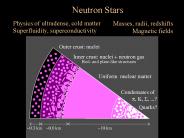Hypernovae PowerPoint PPT Presentations
All Time
Recommended
Ideal Relativistic MHD - no physical resistivity (only numerical); 8. MFoGRBP, SAO, Bukovo ... 1) MHD waves must be able to escape from the black hole ergosphere ...
| PowerPoint PPT presentation | free to download
GRB as superstrong cosmic explosions. Association with supernovae a critical view ... HETE2: GRB-X-ray rich-XRF (Lamb et al. 2003) Apparently continuous. transition ...
| PowerPoint PPT presentation | free to view
Form of light: all light travels in waves classified according to ... Keck, Hawaii, 2days after outburst. Two months later - only a very faint galaxy remains ...
| PowerPoint PPT presentation | free to view
Neutron Stars. Physics of ultradense, cold matter. Superfluidity, ... Origin of Spin, Kicks, B-field -- Magnetars vs. Pulsars. Hypernovae GRBs. Black Hole? ...
| PowerPoint PPT presentation | free to download
sources of UHECR are unknown: are they galactic or extragalactic (AGN, GRB, Hypernovae... The only information comes from observations of Faraday rotation ...
| PowerPoint PPT presentation | free to download
To catch the sign of proton acceleration. GLAST will be Launched May in this year. ... Proton acceleration efficiency. We need 6-8 1043 ergs/Mpc3/yr to explain UHECRs ...
| PowerPoint PPT presentation | free to download
Gefangen im Wirbel aus Raum und Zeit - Rotierende Schwarze L cher 08.12.2004 AK Astronomie Universit t Stuttgart Andreas M ller Theoriegruppe Landessternwarte ...
| PowerPoint PPT presentation | free to download
Exploding stars And the modeling of Dwarf galaxies http://www.spacetoday.org/images/DeepSpace/Stars/StarWR124Hubble.jpg Dwarf Galaxies What are they?
| PowerPoint PPT presentation | free to download
d3 dc1 resceu ipmu ...
| PowerPoint PPT presentation | free to download
Gamma Ray Bursts Shamelessly stolen from Chris Fryer s summer school lectures
| PowerPoint PPT presentation | free to view
The MonKey Project An Update on Stellar Yields
| PowerPoint PPT presentation | free to download
Lines shift back and forth across each other every 164 days due to jet precession 0 SS 433 is most likely a black hole! In 1963, a nuclear test ban treaty was signed ...
| PowerPoint PPT presentation | free to download
Gamma rays are believed to come from the internal shocks, produced in the ... Collimation (1o ? 20o)? Rates (about 3 10-5 per year per galaxy) ...
| PowerPoint PPT presentation | free to view
Baryon poor fireball (BPJ) ~300. slow wind. Bow shock: source of keV photons. r 1011 cm ... (b)=baryons, ( ) = pairs, (r) = radiation. Basic equations. How to ...
| PowerPoint PPT presentation | free to download
J. Garrett Jernigan. MIT. George R. Ricker (PI) Geoffrey Crew ... Gilbert Vedrenne. Jean-Francois Olive. Michel Boer. UChicago. Donald Q. Lamb. Carlo Graziani ...
| PowerPoint PPT presentation | free to download
Title: PowerPoint Presentation Author: GAZ Last modified by: GAZ Created Date: 1/1/1601 12:00:00 AM Document presentation format: (4:3) Other titles
| PowerPoint PPT presentation | free to download
0 Chapter 14 Neutron Stars and Black Holes
| PowerPoint PPT presentation | free to download
Isotropic gamma-ray energies range from 1051 to 1054 erg ... THREE INTERESTING GAMMA-RAY BURST/SUPERNOVA PARAMETERS. THE Epeak-Eisotropic energy RELATION ...
| PowerPoint PPT presentation | free to download
High energy Astrophysics Mat Page Mullard Space Science Lab, UCL 11. Gamma-ray bursts
| PowerPoint PPT presentation | free to view
Formation & Evolution of Planets. Sun / Dynamo-driven ... schools in the Ruhr Valley as well as in Lower Saxony. Summer 2002. The Basic Idea of the Project ...
| PowerPoint PPT presentation | free to view
a brief history of andreas m ller theory group max camenzind lsw heidelberg http://www.lsw.uni-heidelberg.de/users/amueller student seminar mpia & lsw
| PowerPoint PPT presentation | free to download
GRB Gamma Ray Bursts An Ongoing Mystery, Evolving Quickly John G. Learned University of Hawaii with s from many folks, Particularly Kevin Hurley and Guido ...
| PowerPoint PPT presentation | free to download
I) Black hole accretion disk models (compact binary merger, collapsar) ... Black Hole Accretion Disk Models. Collapsar (aka hypernova: ...
| PowerPoint PPT presentation | free to view
Mosaic II = 36'x36' ESO WFI = 34'x33' OmegaCam = 1ox1o. 75' Student seminar ... Only if observing close to the ecliptic. Generally not associated with a galaxy ...
| PowerPoint PPT presentation | free to view
High Resolution X-Ray/UV Spectroscopy of the Intergalactic Medium: Hunting and Modeling the Missing Baryons in the WHIM Fabrizio Nicastro (Harvard-Smithsonian Center ...
| PowerPoint PPT presentation | free to download
After three centuries of work, we have a reasonably complete picture for how ... Possible Stellar Contrail? Quark Stars? RX J1856.5-3754. Dr. Jeremy Drake ...
| PowerPoint PPT presentation | free to view
Title: Author: Tomonori Totani Last modified by: Created Date: 3/19/2004 4:44:39 AM
| PowerPoint PPT presentation | free to download
of relativistic jet (BZ-process, Neutrino Heating), which we are ... Neutrino heating processes have been included in the collapsar model. ...
| PowerPoint PPT presentation | free to download
2004: Swift / BAT / XRT / UVOT. Early afterglows. Detected first short GRB afterglow. http://heasarc.gsfc.nasa.gov/docs/swift/swift.html. GRB Types and Light Curves ...
| PowerPoint PPT presentation | free to view
Louisiana State University, Baton Rouge, LA, USA ... 1051 ergs in the blast wave. SN rate 2/century 2X1049ergs/yr. Blast wave must convert ~1% of its energy into ...
| PowerPoint PPT presentation | free to view
Note that the following lectures include animations and PowerPoint effects such as fly ins and transitions that require you to be in PowerPoint's Slide Show mode
| PowerPoint PPT presentation | free to download
Estimate of magnification in SN1997ff smaller than in Benitez et al 2002, Riess et al 2004. ... Gravitational lensing (de)magnification not a problem for high-z SNe ...
| PowerPoint PPT presentation | free to download
You may find it useful to consult observations in other parts of the ... Precession. Bardeen-Petterson effect. Cosmology. 2nd/resumed inflation or new dynamics ...
| PowerPoint PPT presentation | free to view
Passing GW causes changes in the interferometer arm lengths. ... Of known pulsars Crab pulsar is most promising source, also possible pulsar in SN1987A remnant. ...
| PowerPoint PPT presentation | free to view
The bulge emission is spherically symmetric and is centred on the galactic ... The bulge emission arises from a different source which has only a weak or no ...
| PowerPoint PPT presentation | free to view
Wide Field Optical Surveys
| PowerPoint PPT presentation | free to view
Lecture 3 The role of stars in AGN Evidence for stars in the nuclear regions of type-2 AGN Photoionization models for starbursts Type IIn supernovae: variability
| PowerPoint PPT presentation | free to download
There is another effect that extends SN light curves: Radioactive decay ! (Frank Timmes) ... Nucleosynthesis is a prime constraint for models. 48 ...
| PowerPoint PPT presentation | free to download
Formation of Primordial Protostars. The Final Chapter. Naoki ... Collision Induced Emission. During collisions, a collision. pair acts as a super-molecule' ...
| PowerPoint PPT presentation | free to view
A set search pattern was used during the month of July and observations ... along a line for a half hour and then the pattern was repeated, giving two ...
| PowerPoint PPT presentation | free to view
Classes of pulsars: fmax = 1 kHz, t = 40 yr; fmax = 200 Hz, t = 1000 yr. Stochastic Background ... where rk is the SNR in subband k (normalised templates) ...
| PowerPoint PPT presentation | free to view
Measuring the equation of state with highredshift supernovae
| PowerPoint PPT presentation | free to view
Need Your Own (Robotic) Small Telescopes. Projects which require large amounts of ... Stellar Seismology. Winter 2002/2003. Texas-G ttingen Exoplanet Search ...
| PowerPoint PPT presentation | free to view
The Orion Nebula is one of the most prominent. ... Were it not for the radiation of the O stars, the Orion Nebula would be invisible. ...
| PowerPoint PPT presentation | free to download
Title: PowerPoint Presentation Last modified by: Stan Woosley Created Date: 10/29/2001 7:41:19 PM Document presentation format: Custom Other titles
| PowerPoint PPT presentation | free to download
[Blandford 76; Lovelace 76] [Waxman 95, Vietri 95, Milgrom & Usov 95] ... Linda Smith (University College London), WIYN//NSF, NASA/ESA. Robert Gendler. M82 M81 ...
| PowerPoint PPT presentation | free to download
... will allow unprecedented, high-resolution, multidimensional, multiphysics ... Exascale computing would allow high-resolution 3-D Radiation-magnetohydrodynamic ...
| PowerPoint PPT presentation | free to view
Xray Spectra of Clusters of Galaxies
| PowerPoint PPT presentation | free to download
Supernovae Lab 9 Let s go Supernova! Stars which are 8x massive than our Sun end their lives in a most spectacular way; they go supernova!
| PowerPoint PPT presentation | free to download
A inch cube of this material with would weigh more than 100 million tons. ... gradually causes much of the disk material to eventually spiral into the black hole. ...
| PowerPoint PPT presentation | free to view
Service d'Astrophysique,CEA, Institut d'Astrophysique de Paris. OUTLINE ... MAJORANA PARTICULE (particle = antiparticle) Positrons produced by different channels ...
| PowerPoint PPT presentation | free to view
fireball external shock with ISM - afterglow emission ... Optical telescopes (afterglow localization, brightness, decay index): always ...
| PowerPoint PPT presentation | free to download
The GRB Coordinates Network (GCN) The third InterPlanetary Network (IPN3) ... Due to the sub-burst longitude and latitude and the geographical distribution of ...
| PowerPoint PPT presentation | free to view
A Crab-like field of 1012 Gauss and a Crab-like rotation. of 33 ms are dynamically unimportant. ... m = 1 single spiral arm mode. Outward transport of angular ...
| PowerPoint PPT presentation | free to download
The Auto Correlation Function. Wavelet analysis. Power Density Spectra. Interpreting ... Quantify intrinsic delay, the 'pulse paradigm' can hide the QG effect ! ...
| PowerPoint PPT presentation | free to view
Free precession. Was thought to damp in 1yr (vortex pinning) ... 22, 1825 (2005): Observations say precession lasts 10yr, visible to galactic ...
| PowerPoint PPT presentation | free to view
























































